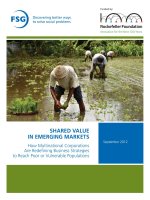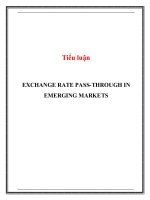Ecotourism and Medical Tourism in Emerging Markets
Bạn đang xem bản rút gọn của tài liệu. Xem và tải ngay bản đầy đủ của tài liệu tại đây (2.91 MB, 38 trang )
Welcome to class of
Ecotourism and Medical Tourism
in Emerging Markets
by
Dr. Satyendra Singh
University of Winnipeg
Canada
www.uwinnipeg.ca/~ssingh5
Honk Kong attracted 28m
international tourist in 2014
London attracted 18m tourists
(2 largest attraction in the world)
Tourist arrival in Cuba, 2010
Darbandsar, Iran…
Darbandsar, Iran
Why Study Tourism?
• Attain peace and prosperity
– Freedom to travel, low passport control
– EC (WWII), USSR, China (1978), Cuba, S. Africa (2004)
• Promotes understanding and trust
– When travel get info about personality, beliefs,
aspirations, perspective, culture, politics…
• Economic development very imp for EMs
– Creates jobs, foreign exchange, face-to-face contacts
• Significant demand and consistent growth
– 500m int’l travelers, 10% of world’s GDP, $3 Trillion
– Low-cost air travel, trading blocks, less barrier
Why is Tourism Important now?
• Need for exchanging ideas and exploration
– Environmentalists, developers, economists, movie
producers, political leaders, professors…need to travel
• Need for cutting cost on defense
– Cannot spend 15% of GDP on defense (USA used to),
and yet meet the need of domestic needs.
– USA 1945 40% of world’s Economy. 1990 only 20%
• Cannot remain in isolation need to share culture
– Isolation breeds distrust, uncompetitive climate
• Tourism makes it possible to maintain Ecosystem
– Set aside land parks, reserve, sanctuary, trees (God)…
– Indigenous people/dance/music/artifacts/heritage sites…
Other Definitions of Ecotourism
• Travelling to undisturbed or uncontaminated
natural areas to study, admire, enjoy
scenery, animals,
• Tourism activities in harmony with nature
opposite of mass tourism
• Benefits to indigenous people
• Conserves environment, sustains the local people
• Conserves ecosystem and host communities
• Foster respect for different culture & human rights
UN, EM and Ecotourism
• Several international agencies promote ecotourism
– UN Global Environment Facility (GEF) funds for
environment-related projects, particularly in EMs
• 500 projects in 120 countries Worth > $2 billion
– USAID (US Agency for International Aids)
• >100 projects worth > $2 billion
• In fact, most Structural Adjustment Programs
(SAP) for emerging markets contain an ecotourism
component
• Also called Staff Monitored Program
Types of Ecotourism
• Non-consumptive ecotourism
– Ecotourism does not consume natural resources
• Tanzania (Serengeti) to observe Zebra
• Nepal to climb mountain
• Belize (Community Baboon sanctuary) to see monkeys
• Consumptive ecotourism
– Ecotourism is based on renewal resources (debatable)
• Shooting elephants, rhinoceroses and antelope
• $20,000 to shoot a single elephant in Zimbabwe
• Leads to substantial revenue, and has minimal adverse impact
on local populations
Convention on International Trade in Endangered
Species of Wild Fauna and Flora (CITES)
www.cites.org
Examples of Ecotourism in EM
• Uganda Bwindi forest gorilla reserve
– $145/person for one hr of viewing gorilla
– 100% of its capacity $400,000 annually
• Nepal Annapurna conservation area
– Ecotourists lodges for trekkers
– $12/person $500,000 annually
• Bolivia Chalalan ecolodge Madidi national park
– Accomodates 24 visitors in hatch-roof cabins, local built
• Costa Rica Monteverde cloud forest reserve
– Located in Tilaran mountains flora and fauna
• Cuba La Moka (UNESCO protected site)
– Bioreserve harmony between people and nature
Creative
eg UN World
heritage status









